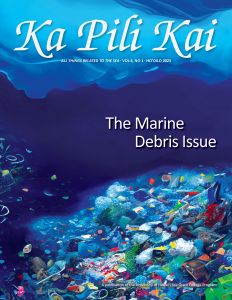Click on the cover image to view the full issue.
On the Cover
The numbers are hard to envision—
8 million metric tons of plastics entering the ocean each year—but the result is something we’ve all experienced: plastics on the beach, in the water, and though we can’t see them, in our bodies as well. Like “forever chemicals,” plastics, once produced, are for all practical purposes here to stay, and exposure to them impairs our health. Plastics production and disposal practices sustain social and environmental injustice worldwide and contribute increasingly to climate change. In this issue of Ka Pili Kai we come face-to-face with plastics pollution and meet visionary scientists working with nonprofits, community members, and government to reduce the harm caused by ocean plastics. The key ingredient in each story is hope, hope that can spur each of us to recognize our addiction to unnecessary, avoidable, and problematic plastics and find inspiration to restore ourselves and our life-sustaining ocean.
By Dr. Mary J. Donohue
Program Specialist, Hawaiʻi Sea Grant
***
He paʻakikī ka hoʻomaopopo ʻana i ka heluna nui o nā mea ea, he 8 miliona kana mekalika, e komo ana i ke kai i kēlā me kēia makahiki. Akā, ʻo ka hopena kekahi mea a kākou i ʻike mua ai: nā mea ea ma kahakai, ka wai, a ma loko o ko kākou mau kino, ʻoiai ʻaʻole hiki ke ʻike maka ʻia. E like me nā “forever chemicals,” aia nō ā hana ʻia nā mea ea, e mau ana nō ka pōʻino, a e pilikia ana ko kākou olakino. ʻO ka hana a me ke kiloi ʻana i nā mea ea, he hana hewa nō ia a puni ka honua, a he mea ʻino ia e hoʻonui ai i ka huli aniau. Ma kēia helu o Ka Pili Kai, e puka ai nā moʻolelo no ka hoʻohaumia mea ea, a me ka poʻe akeakamai e hana ana me nā hui nonprofit, ke kaiāulu, a me ke aupuni i mea e hoʻēmi iho ai i ka pōʻino o nā mea ea ma ka moana. ʻO ka mea nui ma kēlā me kēia moʻolelo, ʻo ia nō ka manaʻolana. ʻO ka manaʻolana, e hoʻolale ai i ko kākou ʻike ʻana i ka hewa o nā mea ea, a e ulu ana ka hoihoi e pono ai kānaka a me ka moana.
Translated by Alyssa Anderson, PhD
Postdoctoral Fellow, Pacific Islands Climate Adaptation Science Center
Beginning this issue with a welcome from Dr. Mary J. Donohue is unintentionally timely as we say aloha and a hui hou to her after an incredible run of over 20 years with Hawaiʻi Sea Grant. Appropriately, this issue deals with the challenge that professionally, scientifcally, and personally has been so near and dear to her heart and mind. Mahalo, mahalo for everything, Mary. Without you, we would not be the Sea Grant that we are today.
Me ke aloha,
Darren T. Lerner, PhD
Director, Hawai‘i Sea Grant
Click here to view the full issue.
Articles
https://seagrant.soest.hawaii.edu/a-bounty-to-remove-ghost-fishing-gear/
Sea Education Association: Studying Microplastics Aboard a Tall Ship


